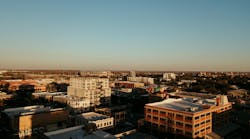To see firsthand a highly successful water conservation program, today more than 140 ranchers, water district managers, state officials, extension agents and researchers toured sites within the Pecos River Ecosystem Project.
Starting from Odessa, the tour, hosted by the Texas Section of the Society for Range Management, included a look at areas along the Pecos River where the program has controlled saltcedar, an invasive tree species that consumes large amounts of water and excretes salt into surrounding water and soil.
Preliminary results of saltcedar control impact studies conducted along the river were also presented to tour participants.
"We're extremely pleased with the results," said Charles Hart, Ph.D., of the Texas Cooperative Extension. "Our goal is to conserve water while improving water quality, and the control of saltcedar we're seeing has been a giant step toward achieving that goal."
The Pecos River Ecosystem Project was established by the Red Bluff Water and Power Control District and the 7 irrigation districts to which it provides water. The project determined that saltcedar is a major risk to the flow and quality of the Pecos River and its tributaries. At the beginning of the project, experts estimated that saltcedar removed as much as 24,000 acre-feet of water per year in the Red Bluff Water and Power Control District alone. Preliminary results presented today show that control of saltcedar has resulted in increased water flow, improved water quality and the return of native vegetation and wildlife to treated areas. In addition, control of saltcedar along the Salt Creek is aiding the Pecos River pupfish, a rare and threatened species, by helping to restore its native habitat. As a result of the habitat restoration efforts, federal officials recently announced that the pupfish is no longer a candidate for the endangered species list.
To date, 120 river miles have been treated with Arsenal(R) herbicide, manufactured by BASF, under a Section 24 (c) local needs exemption. Results indicate 85 to 90 percent control of saltcedar in treated areas.
"Saltcedar has become a plague to water sources across the Southwest," said Mike Standish, market development specialist for BASF, tour sponsor. "It's exciting to see the positive effects controlling saltcedar has had on the Pecos River and the wildlife dependent on it."
The Pecos River Tour was cosponsored by North Star Helicopters, which demonstrated the aerial herbicide spraying that has been so successful in the battle against saltcedar.
Source: BASF Corp.

